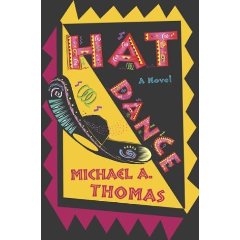 |
|

Book Reviews
Hat Dance,
by Michael A. Thomas
Review by Felisa Rosa Rogers
Published February, 2010
If you can get past the garish cover and the weak first chapter, Hat Dance, by Micahel A. Thomas, is a thoroughly entertaining, if not always satisfying, read.
The premise sounds promising: A gringo journalist and his chilango best friend, a photographer, travel to a remote mountain village to investigate a rebellion spurred by a local landowner’s refusal to help replace the village water pump. They share a van with two documentary filmmakers who don’t speak Spanish: the journalist’s uptight 20-something daughter and her Chicano boyfriend.
 |
|
|
Order Hat Dance
at Amazon.com |
|
That said, the story is alive with the author’s palpable love for Mexico. ‘It’s always cheering to be in Mexico and to know it’, Lee White, the gringo journalist, thinks as he wakes up to the sound of a Tepic fiesta. This sentiment sings through the pages of Hat Dance.
Ultimately, this book is about Mexico. The characters’ different relationships to the country create comedic tension and give Thomas the opportunity to riff, often hilariously, on culture and identity. In a refreshing twist, the contrast is not just between purely gringo and Mexican mentalities. For instance, the Chicano cameraman, Kevin, longs to get in touch with his heritage, but feels lost and belittled in a foreign land. And some of the book’s best scenes are centered on the chilango photographer, Checo, who can’t stand leaving his home town, Mexico City, and views the rest of Mexico as a stagnant and infuriating backwater. Meanwhile, the gringo, Lee, feels more at home with his campesino (peasant) friends Felipe and Elena Pi?eda than with his shrill gringa daughter, Courtney.
The same may be true for Thomas: the passages where Lee and Courtney ruminate on their relationship feel a bit forced, but when the author writes about his Mexican characters, their interactions seem fluid, humorous, and realistic. A chaotic family scene set at the house of Checo’s wealthy parents is a tour de force, read-aloud funny.
The author has a real (and rare) feel for capturing the rhythms of village life, and he gets comedy out of small moments: a television sparks a bargaining war, women gossip as they wash clothes at the river, villagers suspect that a neighboring town is full of witches. The dialog rings true, and Felipe and Elena Pi?eda are warm, lively, and believable. Descriptive passages about the village itself are equally evocative: ‘The store was a box of light in a world that had become very close, wet, and opaque.’
Although Hat Dance is a quick, fun read as is, you almost get the impression that if the gringo characters and their superfluous subplots were swept aside and Thomas just focused on the village, you’d be left with a truly wondrous thing: the living, beating heart of Mexico.
 |
|
|
Order Hat Dance
at Amazon.com |
|
 |
|||
Order
|
|||
Support The People's Guide to Mexico. Click the frog - Donate! |
||
Homepage
|
|||||||||||||||||
|
|||||||||||||||||